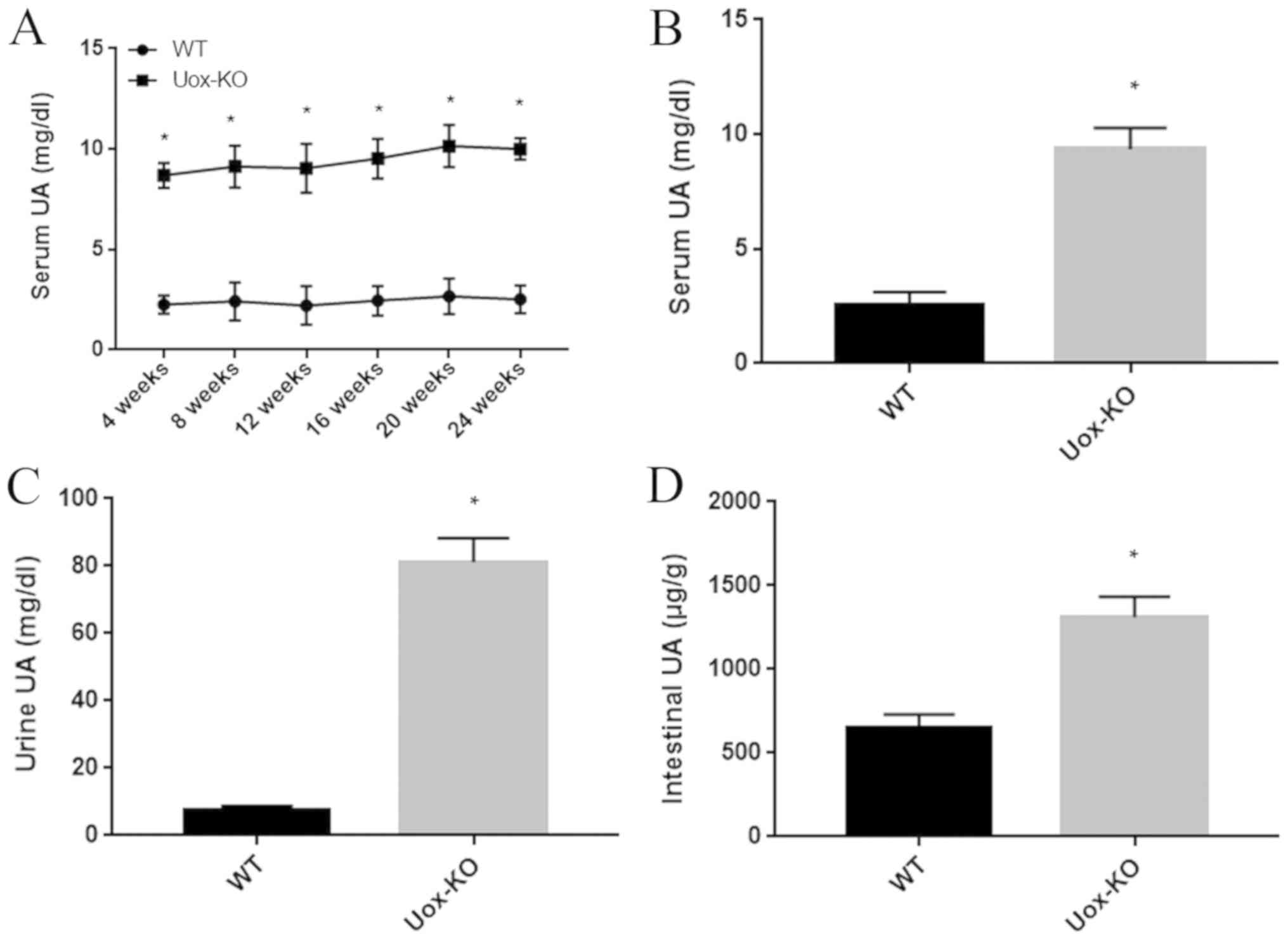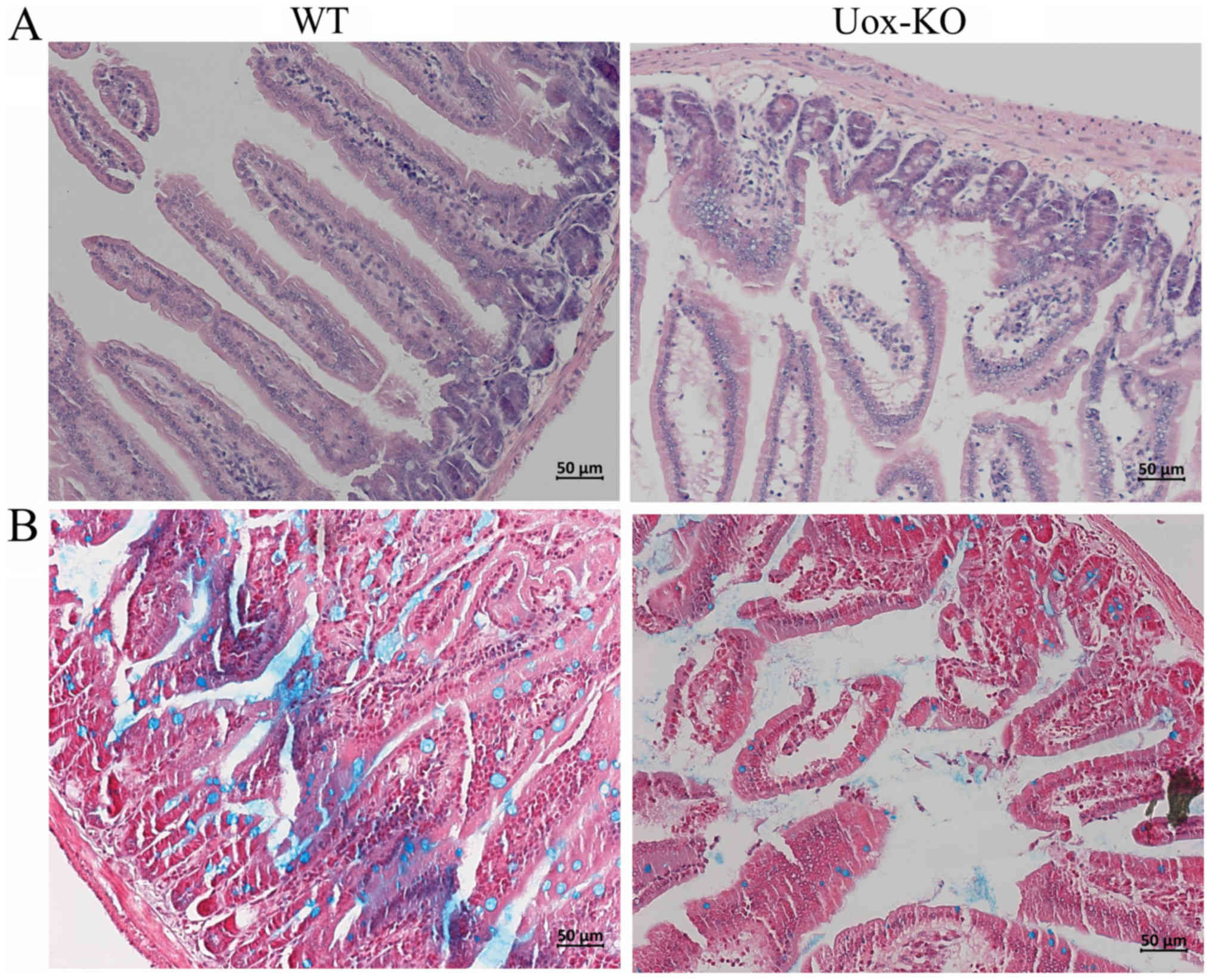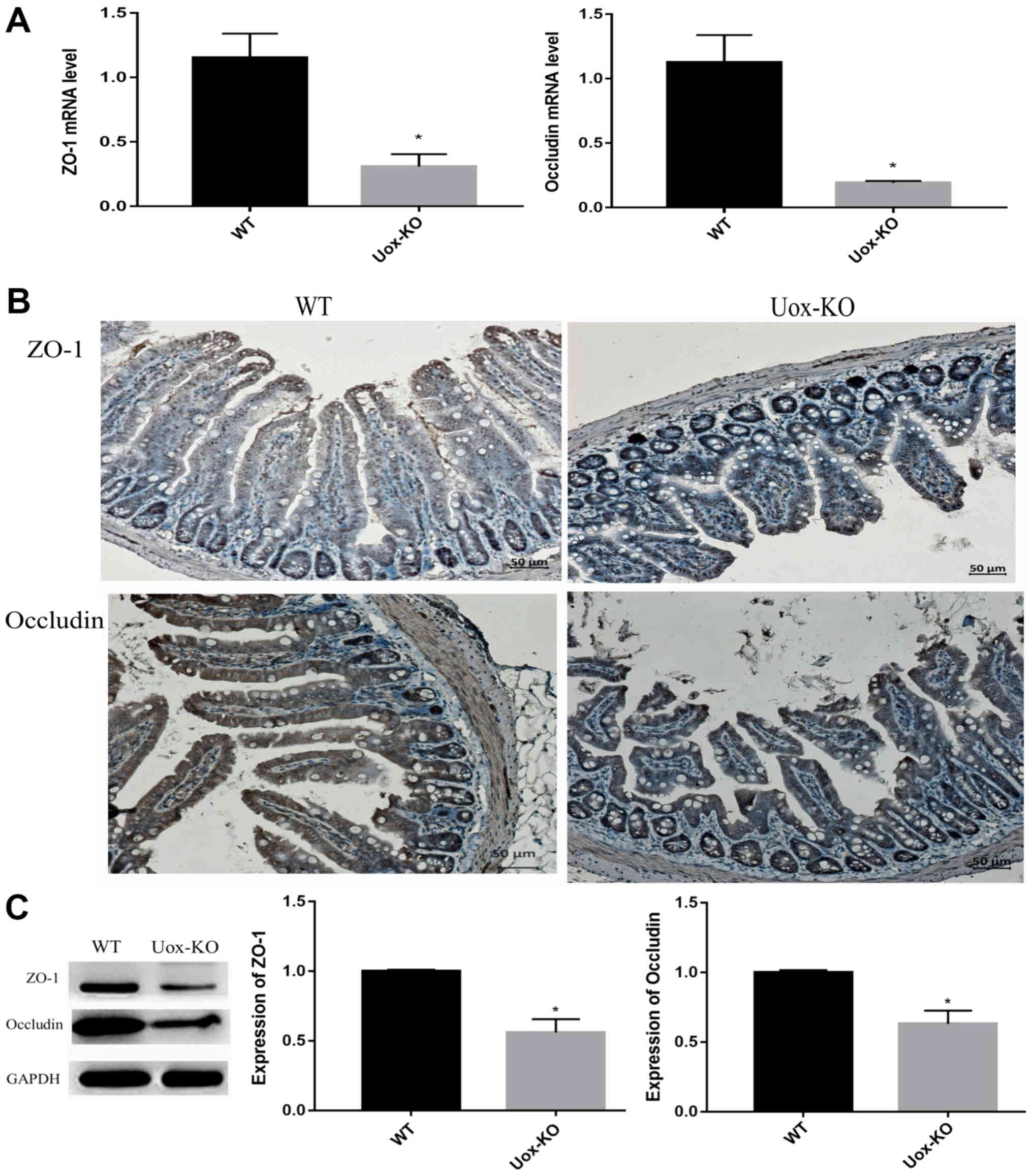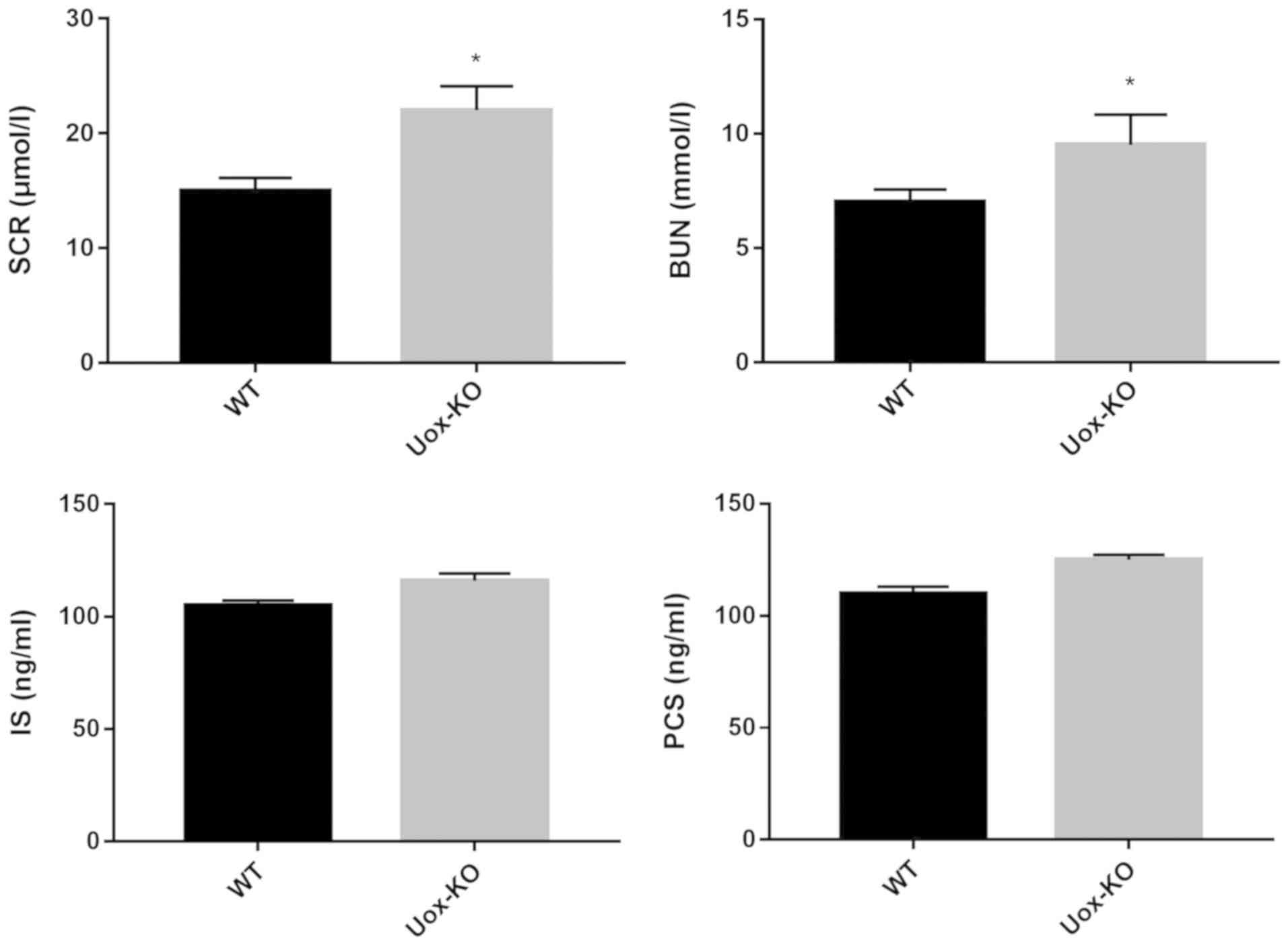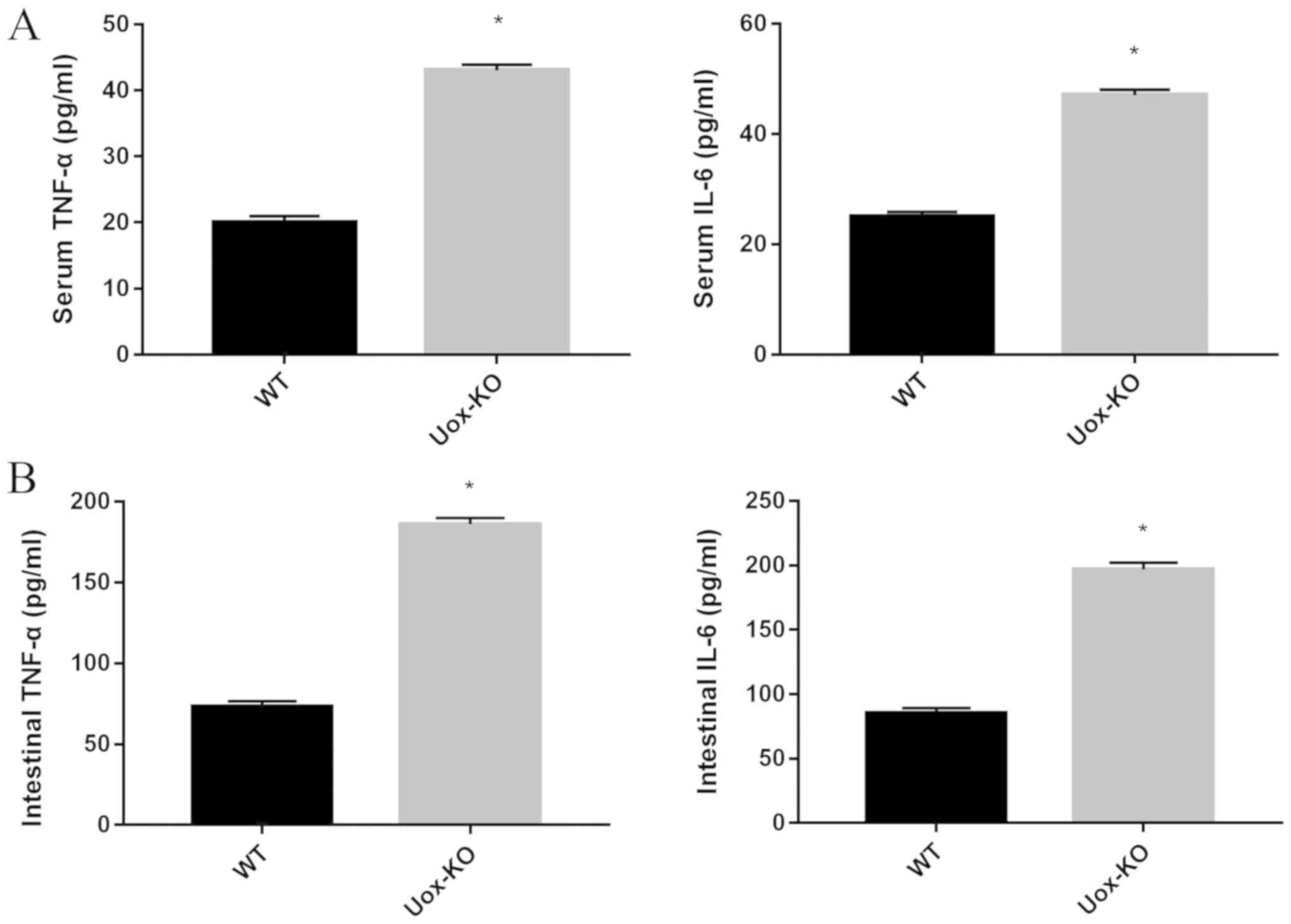|
1
|
Mandal AK and Mount DB: The molecular
physiology of uric acid homeostasis. Annu Rev Physiol. 77:323–345.
2015. View Article : Google Scholar : PubMed/NCBI
|
|
2
|
Álvarez-Lario B and Macarrón-Vicente J:
Uric acid and evolution. Rheumatology. 49:2010–2015. 2010.
View Article : Google Scholar : PubMed/NCBI
|
|
3
|
Liu R, Han C, Wu D, Xia X, Gu J, Guan H,
Shan Z and Teng W: Prevalence of hyperuricemia and gout in mainland
China from 2000 to 2014: A systematic review and meta-analysis.
Biomed Res Int. 2015:7628202015. View Article : Google Scholar : PubMed/NCBI
|
|
4
|
Trifiro G, Morabito P, Cavagna L,
Ferrajolo C, Pecchioli S, Simonetti M, Bianchini E, Medea G,
Cricelli C, Caputi AP and Mazzaglia G: Epidemiology of gout and
hyperuricaemia in Italy during the years 2005–2009: A nationwide
population-based study. Ann Rheum Dis. 72:694–700. 2013. View Article : Google Scholar : PubMed/NCBI
|
|
5
|
Robinson PC: Gout-an update of aetiology,
genetics, co-morbidities and management. Maturitas. 118:67–73.
2018. View Article : Google Scholar : PubMed/NCBI
|
|
6
|
Johnson RJ, Bakris GL, Borghi C, Chonchol
MB, Feldman D, Lanaspa MA, Merriman TR, Moe OW, Mount DB and
Sanchez Lozada LG: Hyperuricemia, acute and chronic kidney disease,
hypertension, and cardiovascular disease: Report of a scientific
workshop organized by the national kidney foundation. Am J Kidney
Dis. 71:851–865. 2018. View Article : Google Scholar : PubMed/NCBI
|
|
7
|
Bonakdaran S and Kharaqani B: Association
of serum uric acid and metabolic syndrome in type 2 diabetes. Cur
Diabetes Rev. 10:113–117. 2014. View Article : Google Scholar
|
|
8
|
Yun Y, Yin H, Gao Z, Li Y, Gao T, Duan J,
Yang R, Dong X, Zhang L and Duan W: Intestinal tract is an
important organ for lowering serum uric acid in rats. PLoS One.
12:e01901942017. View Article : Google Scholar : PubMed/NCBI
|
|
9
|
Xu X, Li C, Zhou P and Jiang T: Uric acid
transporters hiding in the intestine. Pharm Biol. 54:3151–3155.
2016. View Article : Google Scholar : PubMed/NCBI
|
|
10
|
Fini MA, Elias A, Johnson RJ and Wright
RM: Contribution of uric acid to cancer risk, recurrence and
mortality. Clin Transl Med. 1:162012. View Article : Google Scholar : PubMed/NCBI
|
|
11
|
Crane JK and Mongiardo KM:
Pro-inflammatory effects of uric acid in the gastrointestinal
tract. Immunol Invest. 43:255–266. 2014. View Article : Google Scholar : PubMed/NCBI
|
|
12
|
Lu J, Hou X, Yuan X, Cui L, Liu Z, Li X,
Ma L, Cheng X, Xin Y, Wang C, et al: Knockout of the urate oxidase
gene provides a stable mouse model of hyperuricemia associated with
metabolic disorders. Kidney Int. 93:69–80. 2018. View Article : Google Scholar : PubMed/NCBI
|
|
13
|
Lindén SK, Florin TH and McGuckin MA:
Mucin dynamics in intestinal bacterial infection. PLoS One.
3:e39522008. View Article : Google Scholar : PubMed/NCBI
|
|
14
|
Bustin SA, Benes V, Garson JA, Hellemans
J, Huggett J, Kubista M, Mueller R, Nolan T, Pfaffl MW, Shipley GL,
et al: The MIQE guidelines: Minimum information for publication of
quantitative real-time PCR experiments. Clin Chem. 55:611–622.
2009. View Article : Google Scholar : PubMed/NCBI
|
|
15
|
Livak KJ and Schmittgen TD: Analysis of
relative gene expression data using real-time quantitative PCR and
the 2(-Delta Delta C(T)) method. Methods. 25:402–408. 2001.
View Article : Google Scholar : PubMed/NCBI
|
|
16
|
Dvorak K, Higgins A, Palting J, Cohen M
and Brunhoeber P: Immunohistochemistry with Anti-BRAF V600E (VE1)
mouse monoclonal antibody is a sensitive method for detection of
the BRAF V600E mutation in colon cancer: Evaluation of 120 cases
with and without KRAS mutation and literature review. Pathol Oncol
Res. 25:349–359. 2019. View Article : Google Scholar : PubMed/NCBI
|
|
17
|
Wang Y, Yang F, Xue J, Zhou X, Luo L, Ma
Q, Chen YF, Zhang J, Zhang SL and Zhao L: Antischistosomiasis liver
fibrosis effects of chlorogenic acid through IL-13/miR-21/Smad7
signaling interactions in vivo and in vitro. Antimicrob Agents
Chemother. 61(pii): e01347–16. 2017.PubMed/NCBI
|
|
18
|
Zhao Y, Qin GX, Sun Z, Che D, Bao N and
Zhang X: Effects of soybean agglutinin on intestinal barrier
permeability and tight junction protein expression in weaned
piglets. Int J Mol Sci. 12:8502–8512. 2011. View Article : Google Scholar : PubMed/NCBI
|
|
19
|
Song C and Zhao X: Uric acid promotes
oxidative stress and enhances vascular endothelial cell apoptosis
in rats with middle cerebral artery occlusion. Biosci Rep. 38(pii):
BSR201709392018. View Article : Google Scholar : PubMed/NCBI
|
|
20
|
Shen L: Tight junctions on the move:
Molecular mechanisms for epithelial barrier regulation. Ann NY Acad
Sci. 1258:9–18. 2012. View Article : Google Scholar : PubMed/NCBI
|
|
21
|
Wang H, Zhang Q, Niu Y, Zhang X and Lu R:
Surface-layer protein from Lactobacillus acidophilus NCFM
attenuates tumor necrosis factor-α-induced intestinal barrier
dysfunction and inflammation. Int J Biol Macromol. 136:27–34. 2019.
View Article : Google Scholar : PubMed/NCBI
|
|
22
|
Morisaki T: Animal models for abnormal
purine metabolism. Nihon Rinsho. 61 (Suppl 1):S482–S486. 2003.(In
Japanese).
|
|
23
|
Zhu Y, Peng X and Ling G: An update on the
animal models in hyperuricaemia research. Clin Exp Rheumatol.
35:860–864. 2007.
|
|
24
|
Sorensen LB: Role of the intestinal tract
in the elimination of uric acid. Arthritis Rheum. 8:694–706. 1965.
View Article : Google Scholar : PubMed/NCBI
|
|
25
|
Matsuo H, Tsunoda T, Ooyama K, Sakiyama M,
Sogo T, Takada T, Nakashima A, Nakayama A, Kawaguchi M, Higashino
T, et al: Hyperuricemia in acute gastroenteritis is caused by
decreased urate excretion via ABCG2. Sci Rep. 6:310032016.
View Article : Google Scholar : PubMed/NCBI
|
|
26
|
Ruan Z, Liu S, Zhou Y, Mi S, Liu G, Wu X,
Yao K, Assaad H, Deng Z, Hou Y, et al: Chlorogenic acid decreases
intestinal permeability and increases expression of intestinal
tight junction proteins in weaned rats challenged with LPS. PLoS
One. 9:e978152014. View Article : Google Scholar : PubMed/NCBI
|
|
27
|
Xu R, Lei Y, Shi J, Zhou YJ, Chen YW and
He ZJ: Effects of lactadherin on plasma D-lactic acid and small
intestinal MUC2 and claudin-1 expression levels in rats with
rotavirus-induced diarrhea. Exp Ther Med. 11:943–950. 2016.
View Article : Google Scholar : PubMed/NCBI
|
|
28
|
Marchiando AM, Shen L, Graham WV, Edelblum
KL, Duckworth CA, Guan Y, Montrose MH, Turner JR and Watson AJ: The
epithelial barrier is maintained by in vivo tight junction
expansion during pathologic intestinal epithelial shedding.
Gastroenterology. 140:1208–1218.e1-e2. 2011. View Article : Google Scholar : PubMed/NCBI
|
|
29
|
Swidsinski A, Loening-Baucke V, Theissig
F, Engelhardt H, Bengmark S, Koch S, Lochs H and Dörffel Y:
Comparative study of the intestinal mucus barrier in normal and
inflamed colon. Gut. 56:343–350. 2007. View Article : Google Scholar : PubMed/NCBI
|
|
30
|
Van Spaendonk H, Ceuleers H, Witters L,
Patteet E, Joossens J, Augustyns K, Lambeir AM, De Meester I, De
Man JG and De Winter BY: Regulation of intestinal permeability: The
role of proteases. World J Gastroenterol. 23:2106–2123. 2017.
View Article : Google Scholar : PubMed/NCBI
|
|
31
|
Odenwald MA and Turner JR: Intestinal
permeability defects: Is it time to treat? Clin Gastroenterol
Hepatol. 11:1075–1083. 2013. View Article : Google Scholar : PubMed/NCBI
|
|
32
|
Meng Y, Zhang Y, Liu M, Huang YK, Zhang J,
Yao Q, Zhao YL and Xiong JJ: Evaluating intestinal permeability by
measuring plasma endotoxin and diamine oxidase in children with
acute lymphoblastic leukemia treated with high-dose methotrexate.
Anticancer Agents Med Chem. 16:387–392. 2016. View Article : Google Scholar : PubMed/NCBI
|
|
33
|
Honzawa Y, Nakase H, Matsuura M and Chiba
T: Clinical significance of serum diamine oxidase activity in
inflammatory bowel disease: Importance of evaluation of small
intestinal permeability. Inflamm Bowel Dis. 17:E23–E25. 2011.
View Article : Google Scholar : PubMed/NCBI
|
|
34
|
Lau WL, Kalantar-Zadeh K and Vaziri ND:
The Gut as a source of inflammation in chronic kidney disease.
Nephron. 130:92–98. 2015. View Article : Google Scholar : PubMed/NCBI
|
|
35
|
Vaziri ND, Yuan J, Rahimi A, Ni Z, Said H
and Subramanian VS: Disintegration of colonic epithelial tight
junction in uremia: A likely cause of CKD-associated inflammation.
Nephrol Dial Transplant. 27:2686–2693. 2012. View Article : Google Scholar : PubMed/NCBI
|
|
36
|
Adesso S, Ruocco M, Rapa SF, Piaz FD,
Raffaele Di Iorio B, Popolo A, Autore G, Nishijima F, Pinto A and
Marzocco S: Effect of indoxyl sulfate on the repair and intactness
of intestinal epithelial cells: Role of reactive oxygen Species'
release. Int J Mol Sci. 20(pii): E22802019. View Article : Google Scholar : PubMed/NCBI
|
|
37
|
Vaziri ND, Zhao YY and Pahl MV: Altered
intestinal microbial flora and impaired epithelial barrier
structure and function in CKD: The nature, mechanisms, consequences
and potential treatment. Nephrol Dial Transplant. 31:737–746. 2016.
View Article : Google Scholar : PubMed/NCBI
|
|
38
|
Luissint AC, Parkos CA and Nusrat A:
Inflammation and the intestinal barrier: Leukocyte-epithelial cell
interactions, cell junction remodeling, and mucosal repair.
Gastroenterology. 151:616–632. 2016. View Article : Google Scholar : PubMed/NCBI
|
|
39
|
Xin X, Dai W, Wu J, Fang L, Zhao M, Zhang
P and Chen M: Mechanism of intestinal mucosal barrier dysfunction
in a rat model of chronic obstructive pulmonary disease: An
observational study. Exp Ther Med. 12:1331–1336. 2016. View Article : Google Scholar : PubMed/NCBI
|
|
40
|
Wang F, Graham WV, Wang Y, Witkowski ED,
Schwarz BT and Turner JR: Interferon-gamma and tumor necrosis
factor-alpha synergize to induce intestinal epithelial barrier
dysfunction by up-regulating myosin light chain kinase expression.
Am J Pathol. 166:409–419. 2005. View Article : Google Scholar : PubMed/NCBI
|
|
41
|
Zhou Y, Xu GQ, Pu ZY, et al: Relationship
between oxidative stress and inflammatory response in young
patients with primary hyperuricemia. China J Modern Med.
97:e131082017.
|















